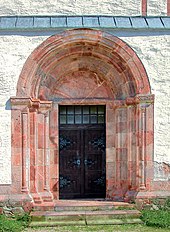St. Nikolai (Geithain)
The Protestant town church St. Nikolai Geithain is a late Gothic hall church with older components in Geithain in the Leipzig district in Saxony . It belongs to the Geithain parish in the Geithainer Land parish in the Evangelical Lutheran Church of Saxony and shapes the townscape of Geithain.
History and architecture
The two-tower west building dates from the Romanesque period , while the choir was built in the 14th century. The late Gothic three-nave nave, which was started in 1504, stands between the two components. However, there was no more vaulting, instead a flat ceiling was installed, which was painted by Adam Schilling in 1594/95. In 1902 the interior was redesigned.
The church is a quarry stone and ashlar structure, the structuring elements such as the corner blocks and the cloaks were highlighted in color. The lower part of the Romanesque west facade is designed as a two-storey block, which is structured by blind arcades, pilaster strips and corner columns. On the second floor there is a group of three pointed arch windows, which probably dates from the 14th century. The very similar tower shafts are provided with coupled round arched windows and are closed off by pointed helmets. A Romanesque portal with three-tiered walls and three-quarter columns with palmette capitals and braided ribbon ornament in the tympanum forms the west entrance. The three-aisled and five-bay hall church is closed off by a high gable roof with a turret . The somewhat asymmetrically arranged choir, shortened when the nave was built, ends in a slightly irregular five-eighth end . The vaulted choir shows slender pointed arched windows with rich high Gothic tracery , while the windows of the ship are designed with simpler cross-arch tracery forms . A two-story extension houses a former ossuary in the basement .
The ground floor of the west building is closed in the middle with hollow vaults, on the sides with groin vaults. Ornate cube capitals can be found on the corner pillars. On the upper floor, in the middle room, which is open to the nave, a diamond vault is drawn in on four pillars from the 15th century.
The artistic design with paintings on the wooden ceiling by Adam Schilling creates the impression of the interior. The slender, grooved octagonal pillars with the beginning of the vaults with double grooved rib fragments carry arcade arches on which the ceiling rests. In the central nave, the ceiling shows the Last Judgment , surrounded by putti and the coats of arms of those of Bünau , the Brandenburg and Electoral Saxon coats of arms. The apostles are depicted in the margins; Typological representations from the Old and New Testament can be found in the side aisles . In the south aisle, the artist's coat of arms, the resurrection , the crucifixion, circumcision and the birth of Christ are depicted with the portrait of Luther . In the north aisle you can find St. Nicholas, the erection of the brazen serpent , the sacrifice of Isaac , the creation of Adam and Eve with the portrait of Philipp Melanchthon . The paintings are combined with painted frames, strips and fillings, the richness of which is rich in decorative elements based on Dutch and Italian models.
In the north-east corner of the nave is the sacristy with a rich star vault and keel arched door; above it is a gallery with a richly decorated parapet. Galleries from 1902 are built into three sides of the ship. Richly decorated boxes from the 18th century with Christian emblems are built into the parapet on the south wall.
Furnishing
The main piece of equipment is an altar by Michael Grüneberger from Freiberg from around 1611 with a two-storey structure, alabaster reliefs and rich figurative decorations. In the predella it shows a representation of the Last Supper flanked by the adoration of the shepherds and the baptism of Christ . In the main field is a sandstone relief of the crucifixion with a painted landscape in the background, framed by two coupled Tuscan columns . The Entombment with the scene of the Mount of Olives and the Descent from the Cross is depicted above the cornice . In Altar extract a relief is Assumption arranged.
The richly decorated pulpit from 1597 on an angel figure is the work of Peter Beseler from Freiberg and shows the evangelists and the Agnus dei on the basket . The coats of arms of the city of Geithain, Saxony and Brandenburg as well as those of Bünau and a citizen of Geithain are attached to the pulpit stairs. The handrail is designed as a tendril. The sound cover shows God the Father and putti who carry the instruments of suffering . The choir stalls from 1473 are decorated with a variety of tracery forms in carved relief. A high quality, larger than life crucifix from the beginning of the 16th century is attached to the triumphal arch. An evangelical confessional from the 18th century with a curved attachment with a coat of arms shows painted floral representations and sayings on the parapet.
The organ with 36 registers on two manuals and pedal shows a broad prospect in neo-renaissance forms and was originally designed by Alfred Schmeisser in 1902.
literature
- Georg Dehio : Handbook of the German art monuments. Saxony II. The administrative districts of Leipzig and Chemnitz. Deutscher Kunstverlag, Munich / Berlin 1998, ISBN 3-422-03048-4 , pp. 309-311.
- Fritz Löffler : The city churches in Saxony. 4th edition. Evangelische Verlagsanstalt, Berlin 1980, p. 212.
Web links
Individual evidence
- ↑ Information about the church on the website of the parish Geithainer Land. Retrieved December 14, 2017 .
Coordinates: 51 ° 3 ′ 15.5 " N , 12 ° 41 ′ 20.8" E




